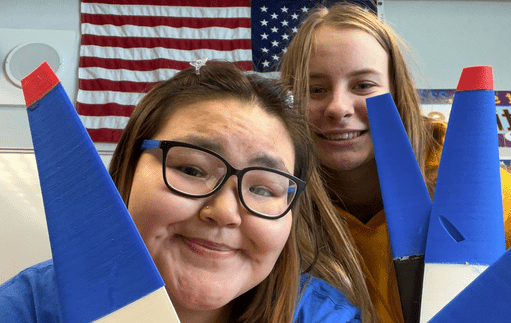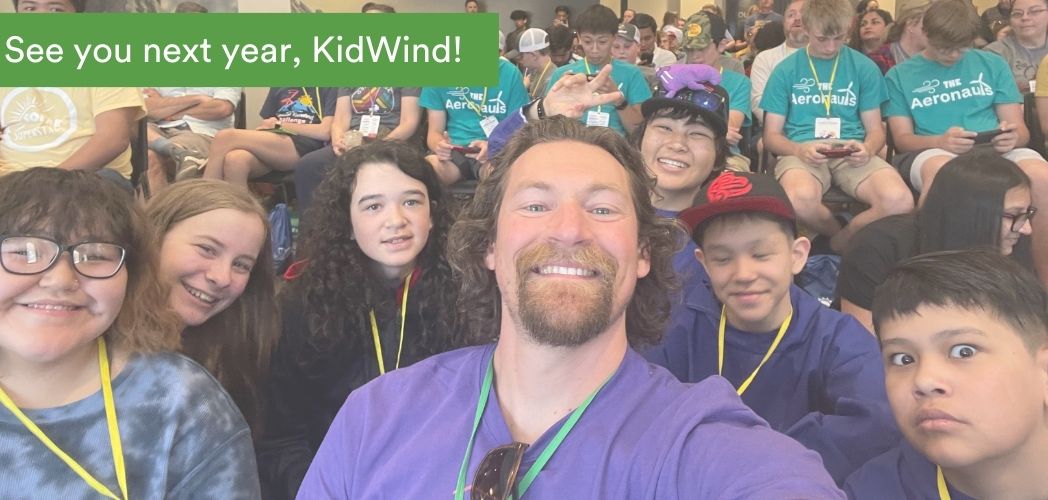Atop the Clean Energy Podium
Two teams from Gambell participated in the 2023 Clean Energy Olympics, the statewide wind turbine design competition hosted by REAP. Gambell’s middle school team, Qughsatkut Wind Blazers, was named after the school’s mascot: a legendary king polar bear of Sivuqaq Island. The team tried various materials for their wind turbine blades including paper, cardboard, balsawood, and whale baleen. Yes, whale baleen! When the community heard the students wanted to test baleen, a local carver generously gifted a stack of baleen plates and taught the students how to shape, sand, and carve them. After lots of refining, the team produced four shiny, black, keratin blades that even bore some hand-carved messages from the students. And these blades didn’t only look good, they performed well too! Team Qughsatkut Wind Blazer took 1st Place in the Middle School Virtual Division of the Alaska Clean Energy Olympics.
Gambell’s high school team, KieKat’s 3D Blades, also took a place-based approach and researched the blade dimensions of the utility-scale wind turbines in their community. After settling on a blade profile, they changed the proportions to fit their test turbine and began coding and 3D printing their blades. Their final design closely resembled Gambell’s utility-scale turbines but with a blue and black color scheme to reflect their school colors, and also, to prevent mini-bird strikes. KieKat’s 3D Blades took 3rd Place in the High School Division.
Gambell’s Clean Energy Olympics’ success was enough to earn each team an invitation to the 2023 National KidWind Challenge in Boulder, CO last May!



On the National Stage
Gambell’s trip to Boulder got off to a bumpy start, as a stubborn Bering Sea storm delayed their flight off Sivuqaq Island by a day. But the teams and their dedicated coaches got out the next day and endured 24 hours of travel including four flights and a few bus rides to the University of Colorado campus. Once the REAP education team finally caught up with them on campus, the students began listing off the novel things they had seen along the way like semi-trucks, traffic lights, escalators, swimming pools, and other things they don’t have in Gambell. Unfortunately, the travel delays put the teams behind schedule and, after a quick nap under their team table, they were thrown into the whirlwind of the competition.
Both teams completed a condensed list of events including wind tunnel testing, presentations to judges, three instant-challenges, a knowledge test, and a science communication challenge. Throughout the event, the students amazed the judges with their competitive spirit, endurance, and Indigenous pride.
They even got a little help from their friends. Veteran teams from Wasilla’s American Charter Academy were also competing in Nationals and didn’t hesitate to help the Gambell teams when their flights were delayed. Before long, the Alaska teams were the talk of the judge’s evening meetings.
Winner Winner…Muktuk Dinner?
After all the events were complete and scores were tallied, the 82 competing teams gathered for the awards ceremony. The Qughsatkut Wind Blazers earned a highly coveted Blade Engineering award for their whale baleen blades. All the students were in shock and Coach Gladys shed tears of joy. After all the trials and tribulations, the Gambell crew triumphantly returned to Alaska with some new metal to add to the trophy case at the John Apangalook School.
Although the teams from Gambell did not build the most powerful turbines, they represented their culture and community with pride. They innovated the use of whale baleen for wind turbine blades, worked together to earn championships at the State level, persevered through nightmarish travels, thrived in a new, overwhelming place surrounded by 400 strangers, and proudly shared their culture with all the judges.
